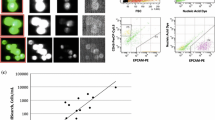Summary
In order to evaluate subarachnoid dissemination of brain tumor, the cerebrospinal fluid (CSF) cells of 104 patients with brain tumor were examined by 3H-thymidine autoradiography and cytology. As a control CSF cells from 34 patients with non-neoplastic disease were examined by the same method. Immediately after withdrawal by lumbar or ventricular puncture, the CSF was incubated with an admixture of 3H-thymidine at a concentration of 1–2 μCi/ml CSF at 37°C for 1 h. The CSF cells were collected by sedimentation or centrifugation and the microautoradiographic procedure was performed. The labeling index (LI) of CSF cells was counted excluding small lymphocytes and polymorphonuclear leukocytes. Labeled CSF cells were found in 33 of 34 cases of non-neoplastic cases. The mean LI of CSF cells in non-neoplastic cases was 0.4% and the highest was 1.7%. Cytological study revealed neoplastic CSF cells in 15 of 104 cases of brain tumor. A LI exceeding 1.7%, which was the highest in non-neoplastic cases, was encountered in 24 of 104 neoplastic cases. The highest LI in neoplastic cases was 14.4% in a case of primary reticulum cell sarcoma of the brain. High labelings were seen in cases of primary brain sarcoma, metastatic carcinoma, meningeal leukemia and pinealoma. In cases of glioma, even though malignant, the LI was relatively low in most cases. High LIs were parallel with the result of cytology in most cases. It was suggested that either 3H-thymidine autoradiography or cytology of CSF cells alone was not always conclusive for the diagnosis of subarachnoid dissemination of brain tumor, but by using both methods the diagnosis would be obtained with more accuracy.
Zusammenfassung
Um eine subarachnoideale Ausbreitung des Tumors auszuwerten, wurden die Liquorzellen von 104 Patienten mit Hirntumoren mittels 3H-Thymidin-Autoradiographie und Cytologie untersucht. Zur Kontrolle wurden die Liquorzellen von 34 Patienten mit nicht-neoplastischen Krankheiten des zentralen Nervensystems nach der gleichen Methode untersucht. Sofort nach der Lumbal- oder Ventrikelpunktion wurde der entnommene Liquor in vitro bei 37°C für 1 Std. mit 3H-Thymidin (1–2 μCi/ml Liquor) inkubiert. Die Zellen wurden durch Sedimentation oder Zentrifugation gesammelt und dann ein mikroautoradiographisches Verfahren angewandt. Der Markierungsindex der Liquorzellen wurde nach Ausschluß der kleinen Lymphocyten und Granulocyten berechnet. Markierte Liquorzellen wurden in 33 von 34 nicht-neoplastischen Fällen gefunden. In nicht-neoplastischen Fällen war der durchschnittliche Markierungsindex der Liquorzellen 0,4% und der höchste 1,7%.
Die cytologische Untersuchung zeigte neoplastische Liquorzellen in 15 von 104 neoplastischen Fällen. Ein Markierungsindex von Liquorzellen über 1,7%, d. h. dem höchsten Wert in nicht-neoplastischen Fällen, wurde in 24 von 104 neoplastischen Fällen beobachtet. Der höchste Markierungsindex der Liquorzellen bei Hirntumoren war 14,4% (primäres Reticulumzellsarkom des Gehirns). Hohe Markierungsindexe wurden auch bei primären Gehirnsarkomen, metastatischen Carcinomen, meningealen Leukämien und bei Pinealomen angetroffen. In Fällen von Gliomen — auch bösartigen — war der Markierungsindex der Liquorzellen relativ niedrig. Der hohe Markierungsindex der Liquorzellen entsprach in den meisten Fällen dem Vorkommen von neoplastischen Zellen. Abschließend wird darauf hingewiesen, daß weder die 3H-Thymidin-Autoradiographie noch die Cytologie allein die Beurteilung einer subarachnoidealen Aussaat eines Tumors endgültig gestattet, daß aber durch Anwendung beider Methoden eine größere Genauigkeit erreicht werden kann.
Similar content being viewed by others
References
Baserga, R., Henegar, G. C., Kisieleski, W. E., Lisco, H.: Uptake of tritiated thymidine by human tumors in vivo. Lab. Invest. 11, 360–364 (1962)
Dommasch, D., Grüninger, W., Schultze, B.: Autoradiographic demonstration of proliferating cells in cerebrospinal fluid. J. Neurol. 214, 97–112 (1977)
Frindel, E., Malaise, E., Tubiama, M.: Cell proliferation kinetics in five human solid tumors. Cancer 22, 611–620 (1968)
Fukui, M., Yamakawa, Y., Yamasaki, T., Kitamura, K., Tabira, T., Sadoshima, S.: 3H-thymidine autoradiography of CSF cells in primary reticulum cell sarcoma of the brain. J. Neurol. 210, 143–150 (1975)
Fukuma, S., Taketomo, S., Ueda, S., Ohmachi, J., Toyama, M., Kitamura, T., Yoshida, S., Maekawa, J., Nakamura, K., Fujita, S.: Autoradiographic studies on human brain tumors in vivo local labeling with 3H-thymidine. Brain and Nerve (Tokyo) 21, 1029–1035 (1969)
Hoshino, T., Baker, M., Wilson, C. B.: Cell kinetics of human gliomas. J. Neurosurg. 37, 15–26 (1972)
Killman, S. A., Cronkite, E. P., Robertson, J. S., Fliedner, T. M., Bond, V. P.: Estimation of phases of the life cycle of leukemic cells from labeling in human beings in vivo with tritiated thymidine. Lab. Invest. 12, 671–684 (1963)
Kury, G., Carter, H. W.: Autoradiographic study of human nervous system tumor. Arch. Path. 80, 38–42 (1965)
Polmeteer, F. E., Kernohan, J. W.: Meningeal gliomatosis. Arch. Neurol. Psychiat. 57, 593–616 (1947)
Russell, D. S., Rubinstein, L. J.: Pathology of tumours of the nervous system. Baltimore: Wiliams and Wilkins 1971
Sörnäs, R.: A new method for the cytological examination of the cerebrospinal fluid. J. Neurol. Neurosurg. Psychiat. 30, 568–577 (1967)
Yamakawa, Y., Fukui, M., Ohta, H., Kitamura, K.: 3H-thymidine autoradiography of the CSF cells in cases of non-neoplastic disease. J. Neurol. 211, 195–202 (1976)
Zülch, K. J.: Brain tumors, their biology and pathology, pp. 107–108. New York: Springer 1965
Author information
Authors and Affiliations
Rights and permissions
About this article
Cite this article
Ohta, H., Fukui, M., Yamakawa, Y. et al. A study of CSF cells by 3H-thymidine autoradiography and cytology regarding the subarachnoid dissemination of brain tumor. J. Neurol 217, 243–251 (1978). https://doi.org/10.1007/BF00312985
Received:
Issue Date:
DOI: https://doi.org/10.1007/BF00312985




